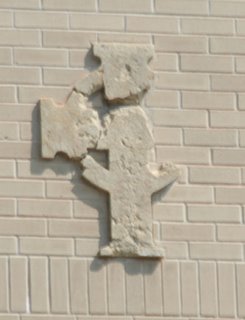
This cross was broken the morning of Thursday, April 19, 1995.
It once stood at the top of the Cathedral’s high-peaked roof. It watched Oklahoma City grow in the 50s, then atrophy in the 60s and 70s.
The Cathedral is about two blocks northeast of the Oklahoma City Bombing Memorial. Where the Alfred P. Murrah Federal Building once stood.
On the morning of April 19, Timothy McVeigh parked a panel truck in front of the federal building, then detonated a home-made bomb. 168 people were killed.
The Cathedral was one of three downtown churches affected by the blast. Stained glass windows were broken. The tall walls of the sanctuary visibly moved back and forth.
And this old Celtic cross was broken.
It may seem like a scar. We try to hide scars. I try to hide my scars. I won’t stop to enumerate them all, but they each have a story.
I try to hide my scars. They expose my weakness. They whisper of old pain. I want to seem strong. I want to give the appearance that I can wander this world on my own, without anyone else’s help.
When the Cathedral rebuilt, all involved agreed the Broken Cross had to be integrated into the design. Some new property was bought, and a high wall and wrought-iron gate were built. This Broken Cross is in the brickwork above that gate.
The Broken Cross can represent many things. How people around the world responded to the tragedy of April 19 with profound generosity. How this generosity, and the vision of the Cathedral’s leaders, allowed the Cathedral to become more than it had been. Accepting such charity is not comfortable.
One must admit one needs help to accept such charity.
Jesus said, “Those who are well have no need of a physician, but those who are sick.” (Lk 5:31).
On the surface, it seems so simple. One must admit he has a problem before he can be healed. The first step in every recovery program is a variation on this: “We admitted we were powerless, and our lives were out of control.” Ironically, the only way we can be restored to any measure of health is by acknowledging our scars.
In other words, the moment we acknowledge our wounds, healing begins. If our life seems like a shattered stained glass window, it is possible to put the pieces back together.
This seems to me the message of the Broken Cross. The brokenness is not the final word. The brokenness is the chink in the armor of our ego, the chink that allows the light to come in. The brokenness is not to be forgotten, or hidden after a measure of healing. Part of the ongoing healing is integrating the brokenness.
Freedom comes when we recognize we are not alone, and don’t have to try to heal ourselves. Freedom comes when we expose our wounds to the light, so they may be healed. Freedom comes when we integrate our strength and weakness.
No comments:
Post a Comment